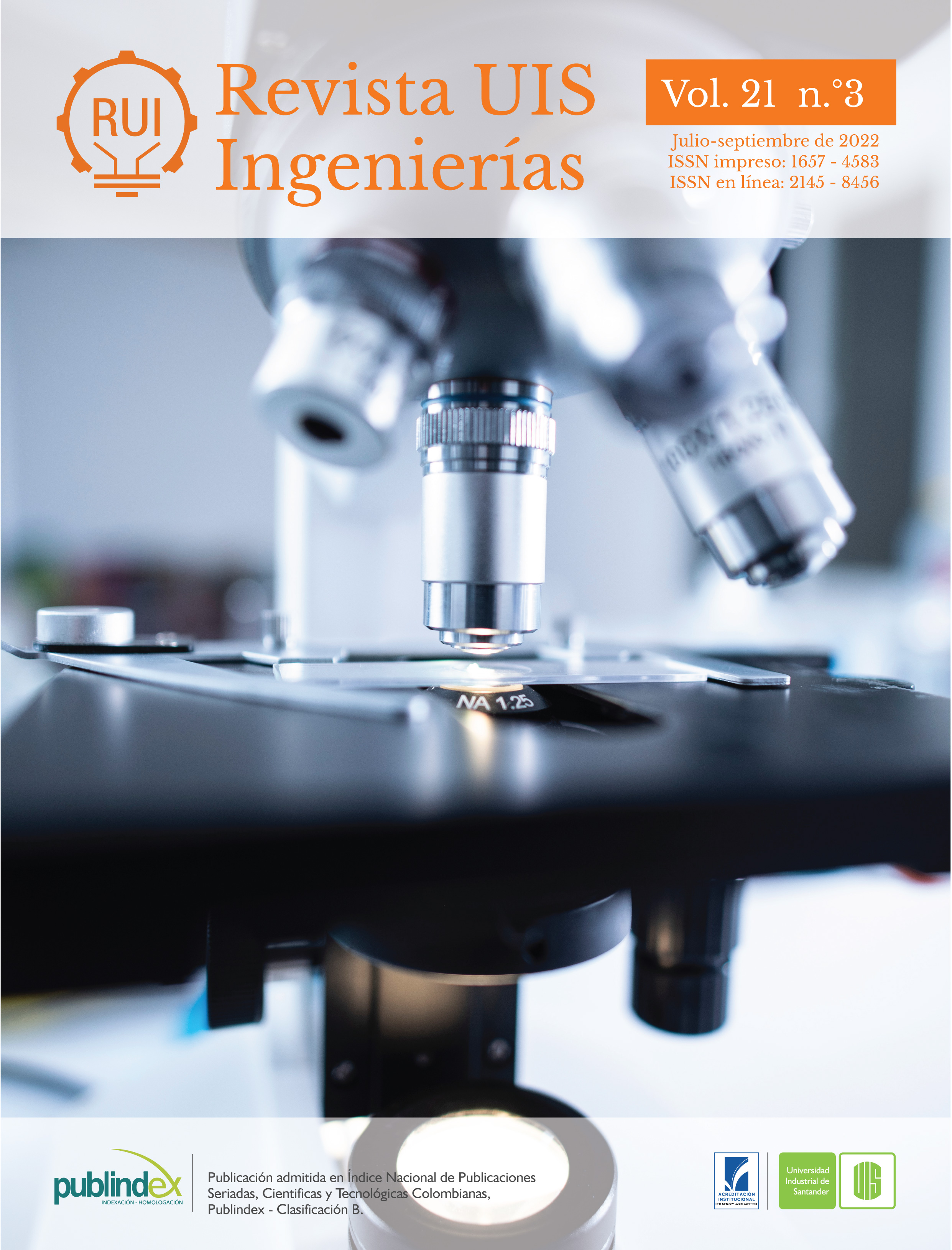Published 2022-07-12
Keywords
- Graphene,
- Graphite,
- Ball Milling,
- Synthesis,
- Characterization
How to Cite
Copyright (c) 2022 Revista UIS Ingenierías

This work is licensed under a Creative Commons Attribution-NoDerivatives 4.0 International License.
Abstract
Due to the rising trend in 2-Dimensional material, graphene has gained a lot of interest in the recent past. Graphene is the 2D carbon allotrope with high strength and improved mechanical, chemical, and electrical properties. Despite being excellent properties among other types of carbon allotropes but still, graphene use is limited because of its costly synthesis technique. In this research, a cheap and effective method is adapted for the preparation of graphene from graphite powder. The graphite powder is thermally treated to prepare the exfoliated graphite then exfoliated graphite is milled to produce the 2D graphene sheets. The synthesized graphene is characterized by X-Ray Diffractometry (XRD) and Scanning Electron Microscope (SEM). The XRD results show that graphene is successfully synthesized, and SEM results show that graphene is 2D which can be used in various applications. This research provides a direction for the synthesis of graphene from graphite powder on an industrial scale.
Downloads
References
- K. S. Novoselova. K. Geims. V. Morozovd. Jiangy. Zhangs. V. Dubonosi. V. Grigorievaand A. A. Firsov, “Electric Field Effect in Atomically Thin Carbon Films,” Science, vol. 306, no. 5696, pp. 666-669, 2004, doi: https://doi.org/10.1126/science.1102896
- K. I. Bolotin et al., “Ultrahigh electron mobility in suspended graphene,” Solid State Communications, pp. vol. 146, pp. 351–355, 2008, doi: https://doi.org/10.1016/j.ssc.2008.02.024
- L. Banszerus et al., “Ultrahigh-mobility graphene devices from chemical vapor deposition on reusable copper,” Science Advances, vol. 1 no. 6, 2015, doi: https://doi.org/10.1126/sciadv.1500222
- A. A. Balandin et al., “Superior Thermal Conductivity of Single-Layer Graphene 2008,” Nano Lett., vol. 8, no. 3, pp. 902–907, 2008, doi: https://doi.org/10.1021/nl0731872
- D. L. Nika, A. A. Balandin, “Phonons and thermal transport in graphene and graphene-based materials,” IOP SCIENCE, vol. 036502, 2017, doi: https://doi.org/10.1088/1361-6633/80/3/036502
- A. A. Balandin, “Phononics of Graphene and Related Materials”, ACS NANO, vol. 14. no. 5, pp. 5170-5178, 2020, doi: https://doi.org/10.1021/acsnano.0c02718
- M. J. Allen, V. C. Tung, R. B. Kaner, “Honeycomb Carbon: A Review of Graphene,” Chem. Rev. vol. 110, no. 1, pp. 132–145, 2010, doi: https://doi.org/10.1021/cr900070d
- C. Lee, “Measurement of the Elastic Properties and Intrinsic Strength of Monolayer Graphene,” SCIENCE, vol. 385, no. 2008, 2012, doi: https://doi.org/10.1126/science.1157996
- F. Bonaccorso, Z. Sun, T. Hasan, and A. C. Ferrari, “Graphene photonics and optoelectronics,” Nature Photonics, vol. 4, pp. 611–622, 2010, doi: https://doi.org/10.1038/nphoton.2010.186
- T. Han et al., “Extremely efficient flexible organic light-emitting diodes with modified graphene anode,” Nature Photonics, vol. 6, pp. 105–110, 2012, doi: https://doi.org/10.1038/nphoton.2011.318
- B. Kulyk et al., “A critical review on the production and application of graphene and graphene-based materials in anti-corrosion coatings,” Crit. Rev. Solid State Mater. Sci., vol. 47, no. 3, pp. 309–355, 2021, doi: https://doi.org/10.1080/10408436.2021.1886046
- J. Y. Lim, N. M. Mubarak, E. C. Abdullah, S. Nizamuddin, M. Khalid, Inamuddin, “Recent trends in the synthesis of graphene and graphene oxide based nanomaterials for removal of heavy metals — A review,” J. Ind. Eng. Chem., vol. 66, pp. 29–44, 2018, doi: https://doi.org/10.1016/j.jiec.2018.05.028
- S. Alam, B. Nizam, U. Maksudul, “Synthesis of graphene,” Int. Nano Lett., vol. 6, pp. 65-83, 2016, doi: https://doi.org/10.1007/s40089-015-0176-1
- N. Kumar et al., “Top-down synthesis of graphene: A comprehensive review,” FlatChem, vol. 27, 2021, doi: https://doi.org/10.1016/j.flatc.2021.100224
- D. Pe, D. Pen, I. Pozo, E. Guitia, “Synthesis of Nanographenes, Starphenes, and Sterically Congested Polyarenes by Aryne Cyclotrimerization,” Acc. Chem. Res., vol. 52, no. 9, pp 2472-2481, 2019, doi: https://doi.org/10.1021/acs.accounts.9b00269
- L. Hlekelele, P. J. Franklyn, K. Tripathi, S. H. Durbach, “Morphological and crystallinity differences in nitrogen-doped carbon nanotubes grown by chemical vapour deposition decomposition of melamine over coal fly ash” RSC Adv., 2016, doi: https://doi.org/10.1039/C6RA16858B
- R. Ye, D. K. James, J. M. Tour, “Laser-Induced Graphene,” Acc Chem Res. Vo. 51, no. 7, pp 1609-1620, 2018, doi: https://doi.org/10.1021/acs.accounts.8b00084
- H. C. Schniepp et al., “Functionalized Single Graphene Sheets Derived from Splitting Graphite Oxide,” J. Phys. Chem. B, vol. 2, pp. 8535–8539, 2006, doi: https://doi.org/10.1021/jp060936f
- N. Antonatos, H. Ghodrati, “Elements beyond graphene: Current state and perspectives of elemental monolayer deposition by bottom-up approach,” Applied Materials Today, vol. 18, 2020, doi: https://doi.org/10.1016/j.apmt.2019.100502
- A. G. Olabi, M. A. Abdelkareem, T. Wilberforce, E. T. Sayed, “Application of graphene in energy storage device – A review,” Renew. Sustain. Energy Rev., vol. 135, 2021, doi: https://doi.org/10.1016/j.rser.2020.110026
- A. S. Nair, V. Nallusamy, K. Jayasankar, S. Ss, “Scalable preparation of graphene from graphite ore via mechano-chemical ball milling,” Mater. Manuf. Process., vol. 37, no. 1, pp. 113–122, 2022, doi: https://doi.org/10.1080/10426914.2021.1945094
- M. A. Saiful Badri, M. M. Salleh, N. F. ain Md Noor, M. Y. A. Rahman, A. A. Umar, “Green synthesis of few-layered graphene from aqueous processed graphite exfoliation for graphene thin film preparation,” Mater. Chem. Phys., vol. 193, pp. 212–219, 2017, doi: https://doi.org/10.1016/j.matchemphys.2017.02.029
- A. A. Naqvi, A. Zahoor, A. A. Shaikh, F. A. Butt, F. Raza, I. U. Ahad, “Aprotic lithium air batteries with oxygen-selective membranes,” Mater. Renew. Sustain. Energy, vol. 11, pp. 33-46, 2022, doi: https://doi.org/10.1007/s40243-021-00205-w

